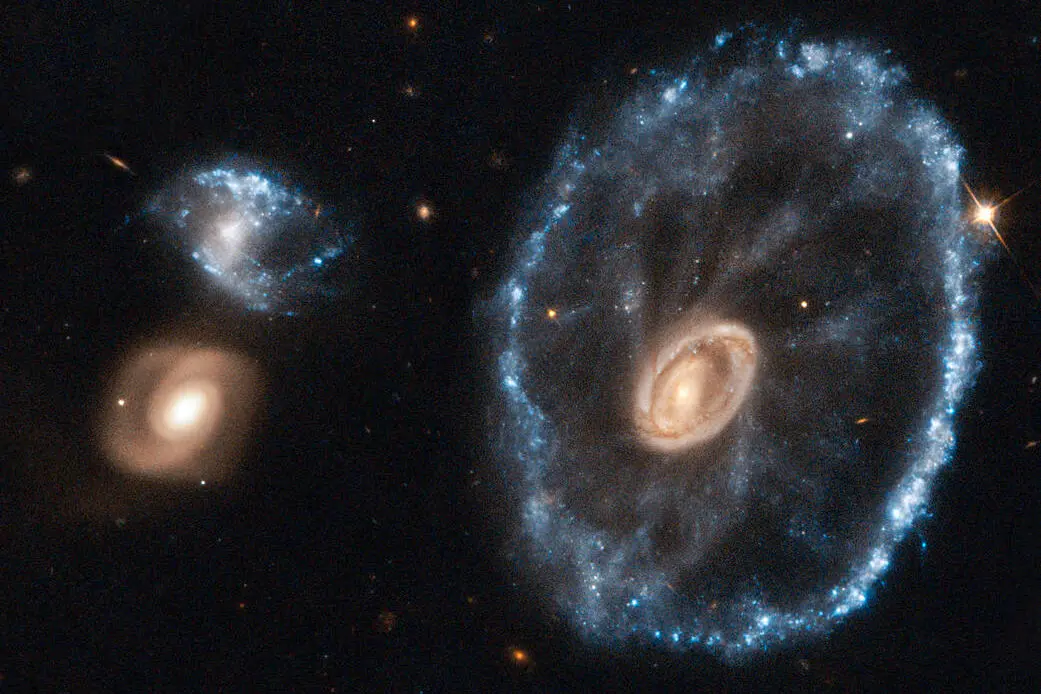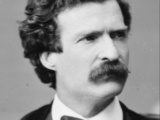
The James Webb Space Telescope recorded new images of the Cartwheel galaxy. This one is a composite made with two tools, the Near-Infrared Camera and the Mid-Infrared Instrument: NASA
The Big Picture –
By Glynn Wilson –
If I was going to hop aboard a worm hole jumping space ship to travel back in time to visit another galaxy, I think I would pick the Cartwheel Galaxy, 500 million light-years from Earth.
I figure if there is a heaven in the expanding universe for cowboys, this must be it.
According to a NASA press release promoting the mission of the new James Webb Space Telescope, scientists say the Cartwheel Galaxy is a rare ring galaxy that was “once shrouded in dust and mystery.” But it has been “unveiled” by the imaging capabilities of Webb.
“The galaxy, which formed as a result of a collision between a large spiral galaxy and another smaller galaxy, not only retained a lot of its spiral character, but has also experienced massive changes throughout its structure,” NASA says. “Webb’s high-precision instruments resolved individual stars and star-forming regions within the Cartwheel, and revealed the behavior of the black hole within its galactic center. These new details provide a renewed understanding of a galaxy in the midst of a slow transformation.”
The telescope peered into the chaos of the Cartwheel, revealing new details about star formation and the central black hole.
While there are no images or videos of covered wagons, hoop skirts or saloon brothels, they must be in there somewhere, right? I mean what’s the point of exploring the vastness of the universe without stopping off at the bar for a shot of good whiskey and a dance with a pretty girl?
What is the point of spending billions of dollars to photograph distant stars if you can’t savor life along the way?
This so-called Cartwheel Galaxy is located about 500 million light-years away from us in the Sculptor constellation, a rare sight, according to NASA. Its appearance, much like that of the wheel of a wagon, is the result of an intense event – a high-speed collision between a large spiral galaxy and a smaller galaxy not visible in the images. Collisions of galactic proportions cause a cascade of different, smaller events between the galaxies involved.
This collision obviously affected the galaxy’s shape and structure. Scientists know this because of a trail of hydrogen gas left behind that was following the smaller galaxy, which has been called the “smoking gun” indicating that it had kept moving after creating Cartwheel’s new formation.
The Cartwheel Galaxy has two rings — a bright inner ring and a surrounding, colorful ring, both expanding outwards from the center of the collision, like ripples in a pond after a stone is tossed in. Because of these distinctive features, astronomers call this a “ring galaxy,” a structure less common than spiral galaxies like our Milky Way.
So our galaxy looks more like a milk shake. I like the idea of a wagon wheel shape. Don’t you?
The bright core contains a tremendous amount of hot dust, which would probably be about as much fun to visit as a dust storm in Arizona in the summertime.
The brightest areas are home to gigantic young star clusters. The outer ring, which has expanded for about 440 million years, is dominated by star formation and supernovas. As this ring expands, it collides with surrounding gas and triggers the formation of new stars, like our Sun.
The Near-Infrared Camera (NIRCam), Webb’s primary imager, looks in the near-infrared range from 0.6 to 5 microns, seeing crucial wavelengths of light that can reveal even more stars than observed in visible light. Young stars, many of which are forming in the outer ring, are less obscured by the presence of dust when observed in infrared light. NIRCam data shows the blue, orange and amber coloring.
You may notice many individual blue dots in the pictures. No, these are not bright blue democrats in red republican territory. They are individual stars or forming stars.
Learning finer details about the dust that inhabits the galaxy requires Webb’s Mid-Infrared Instrument. MIRI data are colored red in this composite image. It reveals regions within the Cartwheel Galaxy rich in hydrocarbons and other chemical compounds, as well as silicate dust, like much of the dust on Earth.
These regions form a series of spiraling spokes that essentially form the galaxy’s skeleton. These spokes are evident in previous Hubble observations released in 2018.
But they become much more prominent in this Webb image.

The MIRI instrument on the Webb telescope was used to reveal the galaxy’s dusty regions and young stars: NASA
Webb’s observations show that the Cartwheel is in a very transitory stage. The galaxy, which was presumably a normal spiral galaxy like the Milky Way before its collision, will continue to transform. While Webb gives us a snapshot of the current state of the Cartwheel, it also provides insight into what happened to this galaxy in the past and how it will evolve in the future.
Let’s just hope one day we will meet the cowboys there, and they will invite us in for a cool drink.














